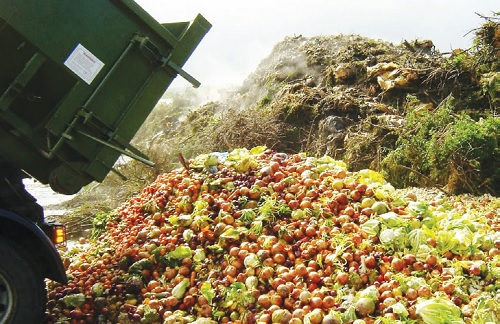
BY STAFF REPORTER
The United Nations estimates that one in nine people in the world does not have access to sufficient food to lead a healthy life. More people are reported to die from hunger every day than AIDS, malaria and tuberculosis combined. But at the same time, nearly one-third of the food that is produced in the world is lost or wasted due to one reason or the other.
Food wastage, which includes both food loss and food waste, is not only morally irresponsible but also causes huge economic losses as well as severe damage to the world around us. An estimated one-third of all the food produced in the world goes to waste, according to worldwildlife.org. That’s equal to about 1.3 billion tons of fruits, vegetables, meat, dairy, seafood, and grains that either never leave the farm, get lost or spoiled during distribution, or are thrown away in hotels, grocery stores, restaurants, schools, or home kitchens. It could be enough calories to feed every undernourished person on the planet.
But wasted food isn’t just a social or humanitarian concern—it’s an environmental one. When we waste food, we also waste all the energy and water it takes to grow, harvest, transport, and package it. And if food goes to the landfill and rots, it produces methane—a greenhouse gas even more potent than carbon dioxide. About 6 to 8 per cent of all human-caused greenhouse gas emissions could be reduced if we stop wasting food. In the US alone, the production of lost or wasted food generates the equivalent of 32.6 million cars’ worth of greenhouse gas emissions.
While food loss happens mainly at the production stage due to insufficient skills, natural calamities, lack of proper infrastructure and poor practices, food waste occurs when edible food is intentionally discarded by consumers after they fail to plan their meals properly and store food till it spoils or goes past the expiry date.
At times, food waste can also happen due to oversupply in markets. Retailers also tend to reject a lot of food because it doesn’t conform to their quality and aesthetic standards. A 2013 FAO (Food and Agriculture Organization of the United Nations) report, which was the first study to analyze the impacts of global food wastage on the environment, says that nearly one-third of all food produced in the world for human consumption does not find its way to our tables.
This comes with a heavy carbon footprint as well. When food is disposed of in a landfill it rots and becomes a significant source of methane – a potent greenhouse gas with 21 times the global warming potential of carbon dioxide. Growing and transporting the food that goes to waste emits as much carbon pollution as 39 million passenger vehicles.
The global food system is responsible for up to one-third of all human-caused greenhouse gas emissions, making it one of the largest contributors to climate change, according to the Consultative Group on International Agricultural Research.
More than 50 per cent of the waste occurs during “upstream,” or the production, yield handling and storage phase and the remaining happens during the processing, distribution and consumption stages or the “downstream” phase.
The FAO report was also able to discern a clear pattern in food waste at the global level. While middle and higher-income regions showed greater food loss and waste during the downstream phase or at the consumption level, developing countries were more likely to lose or waste food at the upstream phase due to a lack of proper harvest techniques and infrastructure.
The later food is wasted along the chain, the greater is its environmental impact because then we also have to take into consideration the energy and natural resources expended in processing, transporting, storing and cooking it. If included in a list of countries ranked according to their greenhouse emissions, food waste would come in the third spot, right after the USA and China.
Food waste that ends up in landfills produces a large amount of methane – a more powerful greenhouse gas than even CO2. For the uninitiated, excess amounts of greenhouse gases such as methane, CO2 and chlorofluorocarbons absorb infrared radiation and heat the earth’s atmosphere, causing global warming and climate change.
With agriculture accounting for 70 per cent of the water used throughout the world, food waste also represents a great waste of fresh water and groundwater resources. It is said that a volume of water roughly three times the volume of Lake Geneva is used just to produce food that is not eaten. By throwing out one kilogram of beef, you are essentially wasting 50,000 litres of water that were used to produce that meat. In the same way, nearly 1000 litres of water are wasted when you pour one glass of milk down the drain.
If you look at land usage, around 1.4 billion hectares of land, which is roughly one-third of the world’s total agricultural land area, is used to grow food that is wasted. Millions of gallons of oil are also wasted every year to produce food that is not eaten. And all this does not even take into account the negative impacts on biodiversity due to activities like monocropping and converting wildlands into agricultural areas.
Ethiopia is losing billions of dollars as a result of food waste and loss, said a scientist at Jimma University on Wednesday. Ali Mohammed professor, who has researched the area, said an estimated 282 billion birr worth of food is wasted or lost in Ethiopia annually.
Exacerbating this is rates of post-harvest food losses reported to range from 30 to 50 per cent. According to another study conducted in Laga Tafo Laga Dadi town in Ethiopia, the per capita food wastage is 92 kgs where it is 99 kg in Nairobi, Kenya and 189 in Nigeria.
The bulk of food loss and waste occurs between harvest and arrival at the processor or manufacturer. This inefficiency wastes millions of dollars every year, undermines farmers’ incomes and exacerbates food and nutrition insecurity. There is so far no robust national data available on this issue, even though it is expected to become increasingly important with anticipated shifts in rural-urban demographics, diets and consumption patterns.
The Ethiopian Herald August 29/2021





